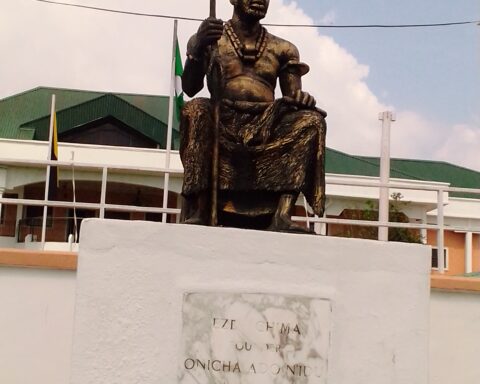By Jesse Voyamba
After two weeks of back and forth, I finally finished reading “Report by Sir F.D. Lugard on the Amalgamation of Northern and Southern Nigeria, and Administration.” This report was not an easy read due to the nature of the text. The report is a 50-page document that shaped the modern Nigerian state.
Review of Sir FD. Lugard’s Report on the Amalgamation of Nigeria
Jesse Voyamba
Follow
6 min read·
17 hours ago
Listen
Share
After two weeks of back and forth, I finally finished reading “Report by Sir F.D. Lugard on the Amalgamation of Northern and Southern Nigeria, and Administration.” This report was not an easy read due to the nature of the text. The report is a 50-page document that shaped the modern Nigerian state.
Photo by Icon News
I had to tick it off my to-do list because I needed something that could fill the gaps and add nuance to what I’d already learned from books and articles on Nigeria’s colonial and post-colonial history, especially the civil war and the administrative changes that followed
Prior to the amalgamation of 1914, Nigeria existed as two distinct protectorates. The Southern and Northern with each having its own administrative structure and economic priorities. The Southern Protectorate was more economically viable due to coastal access, vibrant trade in palm oil, timber, cocoa, and most importantly, it inherited the commercial legacies of earlier British involvement through chartered companies like the Royal Niger Company. During the 19th century, this company acted as a government in the Lower Niger basin thereby controlling trade routes, levying duties, and enforcing local law. On the other hand, the Northern Protectorate though larger in size, was landlocked, struggled financially, and was heavily reliant on grants in form of aid from the British Treasury.
Review of Sir FD. Lugard’s Report on the Amalgamation of Nigeria
Jesse Voyamba
Follow
6 min read·
17 hours ago
Listen
Share
After two weeks of back and forth, I finally finished reading “Report by Sir F.D. Lugard on the Amalgamation of Northern and Southern Nigeria, and Administration.” This report was not an easy read due to the nature of the text. The report is a 50-page document that shaped the modern Nigerian state.
Photo by Icon News
I had to tick it off my to-do list because I needed something that could fill the gaps and add nuance to what I’d already learned from books and articles on Nigeria’s colonial and post-colonial history, especially the civil war and the administrative changes that followed
Prior to the amalgamation of 1914, Nigeria existed as two distinct protectorates. The Southern and Northern with each having its own administrative structure and economic priorities. The Southern Protectorate was more economically viable due to coastal access, vibrant trade in palm oil, timber, cocoa, and most importantly, it inherited the commercial legacies of earlier British involvement through chartered companies like the Royal Niger Company. During the 19th century, this company acted as a government in the Lower Niger basin thereby controlling trade routes, levying duties, and enforcing local law. On the other hand, the Northern Protectorate though larger in size, was landlocked, struggled financially, and was heavily reliant on grants in form of aid from the British Treasury.
Lord Lugard on the Necessity for Amalgamation:
such in brief were the antecedents which had given to the North and South their divergent characteristics and policies. In 1906 a further step in amalgamation was effected in the South. Southern Nigeria and Lagos became one administration under the title of the Colony and Protectorate of Southern Nigeria. From this date the material prosperity of the South increased with astonishing rapidity. The Liquor duties — increased from 3s in 1901 3s.6d in 1905 — stood at 5s.6d, a gallon in 1912 and afforded an ever increasing revenue, without any diminution in the quantity imported. They yielded a sum of £1,138,000 in 1913.
The North, largely dependent on the annual grant from the Imperial Government, was barely able to balance its budget with the most parsimonious economy, and was starved of the necessary staff, and unable to find funds to house its officers properly. Its energies were concentrated upon the development of the Native Administration and the revenue resulting from direct taxation. Its distance from the coast (250 miles) rendered the expansion of trade difficult. Thus the anomaly was presented of a country with an aggregate revenue practically equal to its needs, but divided into two by an arbitrary line of latitude. One portion was dependent on a grant paid by the British taxpayer, which in the year before Amalgamation stood at £136,000 and had averaged £314,500 in 1913 for the 11 years ending March 1912.
This conflicting situation became a concern to Britain, particularly the cost of maintaining and running the Northern Protectorate. At this point, the only viable solution the colonial office envisaged was amalgamation. They believe it would consolidate control, cut costs, and, most importantly, increase profitability. To them, it was all about efficiency and administrative unity.
Review of Sir FD. Lugard’s Report on the Amalgamation of Nigeria
Jesse Voyamba
Follow
6 min read·
17 hours ago
Listen
Share
After two weeks of back and forth, I finally finished reading “Report by Sir F.D. Lugard on the Amalgamation of Northern and Southern Nigeria, and Administration.” This report was not an easy read due to the nature of the text. The report is a 50-page document that shaped the modern Nigerian state.
Photo by Icon News
I had to tick it off my to-do list because I needed something that could fill the gaps and add nuance to what I’d already learned from books and articles on Nigeria’s colonial and post-colonial history, especially the civil war and the administrative changes that followed
Prior to the amalgamation of 1914, Nigeria existed as two distinct protectorates. The Southern and Northern with each having its own administrative structure and economic priorities. The Southern Protectorate was more economically viable due to coastal access, vibrant trade in palm oil, timber, cocoa, and most importantly, it inherited the commercial legacies of earlier British involvement through chartered companies like the Royal Niger Company. During the 19th century, this company acted as a government in the Lower Niger basin thereby controlling trade routes, levying duties, and enforcing local law. On the other hand, the Northern Protectorate though larger in size, was landlocked, struggled financially, and was heavily reliant on grants in form of aid from the British Treasury.
Lord Lugard on the Necessity for Amalgamation:
such in brief were the antecedents which had given to the North and South their divergent characteristics and policies. In 1906 a further step in amalgamation was effected in the South. Southern Nigeria and Lagos became one administration under the title of the Colony and Protectorate of Southern Nigeria. From this date the material prosperity of the South increased with astonishing rapidity. The Liquor duties — increased from 3s in 1901 3s.6d in 1905 — stood at 5s.6d, a gallon in 1912 and afforded an ever increasing revenue, without any diminution in the quantity imported. They yielded a sum of £1,138,000 in 1913.
The North, largely dependent on the annual grant from the Imperial Government, was barely able to balance its budget with the most parsimonious economy, and was starved of the necessary staff, and unable to find funds to house its officers properly. Its energies were concentrated upon the development of the Native Administration and the revenue resulting from direct taxation. Its distance from the coast (250 miles) rendered the expansion of trade difficult. Thus the anomaly was presented of a country with an aggregate revenue practically equal to its needs, but divided into two by an arbitrary line of latitude. One portion was dependent on a grant paid by the British taxpayer, which in the year before Amalgamation stood at £136,000 and had averaged £314,500 in 1913 for the 11 years ending March 1912.
This conflicting situation became a concern to Britain, particularly the cost of maintaining and running the Northern Protectorate. At this point, the only viable solution the colonial office envisaged was amalgamation. They believe it would consolidate control, cut costs, and, most importantly, increase profitability. To them, it was all about efficiency and administrative unity.
In August 1911, the task of finding a solution to the problem of imbalance was assigned to Sir Frederick Lugard (a former High Commissioner of the Northern Protectorate). His experience in military conquest and indirect rule, and constant advocacy for the unification of the two protectorates, made him a good fit. He depended on his wits to resolve this challenge, not through a democratic consensus, rather through a merger.
On 9 May 1913, Lugard submitted a formal proposal to the Colonial Office in which Northern and Southern provinces would have separate administrations, under the control of a “strongly authoritarian” Governor-General. His objective, which was hinged on the British government’s desire to maximize returns from its colonies, established a unified system that maintained British economic interests while keeping direct administrative costs low. The Nigeria he helped create wasn’t for Nigerians. It was for British convenience.
One aspect of the report that had me questioning a lot of things is Lugard’s use of indirect rule. One would expect that in uniting the Northern and Southern protectorates, he would dismantle indigenous political systems. However, he proposed to rule through them. He opted to rule by using Emirs, Obas, and chiefs as intermediaries. While this approach was largely successful due to the already existing hierarchical Islamic structures, it was less successful in the South. The British ended up inventing “chiefs” where none had previously existed.
Review of Sir FD. Lugard’s Report on the Amalgamation of Nigeria
Jesse Voyamba
Follow
6 min read·
17 hours ago
Listen
Share
After two weeks of back and forth, I finally finished reading “Report by Sir F.D. Lugard on the Amalgamation of Northern and Southern Nigeria, and Administration.” This report was not an easy read due to the nature of the text. The report is a 50-page document that shaped the modern Nigerian state.
Photo by Icon News
I had to tick it off my to-do list because I needed something that could fill the gaps and add nuance to what I’d already learned from books and articles on Nigeria’s colonial and post-colonial history, especially the civil war and the administrative changes that followed
Prior to the amalgamation of 1914, Nigeria existed as two distinct protectorates. The Southern and Northern with each having its own administrative structure and economic priorities. The Southern Protectorate was more economically viable due to coastal access, vibrant trade in palm oil, timber, cocoa, and most importantly, it inherited the commercial legacies of earlier British involvement through chartered companies like the Royal Niger Company. During the 19th century, this company acted as a government in the Lower Niger basin thereby controlling trade routes, levying duties, and enforcing local law. On the other hand, the Northern Protectorate though larger in size, was landlocked, struggled financially, and was heavily reliant on grants in form of aid from the British Treasury.
Lord Lugard on the Necessity for Amalgamation:
such in brief were the antecedents which had given to the North and South their divergent characteristics and policies. In 1906 a further step in amalgamation was effected in the South. Southern Nigeria and Lagos became one administration under the title of the Colony and Protectorate of Southern Nigeria. From this date the material prosperity of the South increased with astonishing rapidity. The Liquor duties — increased from 3s in 1901 3s.6d in 1905 — stood at 5s.6d, a gallon in 1912 and afforded an ever increasing revenue, without any diminution in the quantity imported. They yielded a sum of £1,138,000 in 1913.
The North, largely dependent on the annual grant from the Imperial Government, was barely able to balance its budget with the most parsimonious economy, and was starved of the necessary staff, and unable to find funds to house its officers properly. Its energies were concentrated upon the development of the Native Administration and the revenue resulting from direct taxation. Its distance from the coast (250 miles) rendered the expansion of trade difficult. Thus the anomaly was presented of a country with an aggregate revenue practically equal to its needs, but divided into two by an arbitrary line of latitude. One portion was dependent on a grant paid by the British taxpayer, which in the year before Amalgamation stood at £136,000 and had averaged £314,500 in 1913 for the 11 years ending March 1912.
This conflicting situation became a concern to Britain, particularly the cost of maintaining and running the Northern Protectorate. At this point, the only viable solution the colonial office envisaged was amalgamation. They believe it would consolidate control, cut costs, and, most importantly, increase profitability. To them, it was all about efficiency and administrative unity.
In August 1911, the task of finding a solution to the problem of imbalance was assigned to Sir Frederick Lugard (a former High Commissioner of the Northern Protectorate). His experience in military conquest and indirect rule, and constant advocacy for the unification of the two protectorates, made him a good fit. He depended on his wits to resolve this challenge, not through a democratic consensus, rather through a merger.
On 9 May 1913, Lugard submitted a formal proposal to the Colonial Office in which Northern and Southern provinces would have separate administrations, under the control of a “strongly authoritarian” Governor-General. His objective, which was hinged on the British government’s desire to maximize returns from its colonies, established a unified system that maintained British economic interests while keeping direct administrative costs low. The Nigeria he helped create wasn’t for Nigerians. It was for British convenience.
One aspect of the report that had me questioning a lot of things is Lugard’s use of indirect rule. One would expect that in uniting the Northern and Southern protectorates, he would dismantle indigenous political systems. However, he proposed to rule through them. He opted to rule by using Emirs, Obas, and chiefs as intermediaries. While this approach was largely successful due to the already existing hierarchical Islamic structures, it was less successful in the South. The British ended up inventing “chiefs” where none had previously existed.
The policy of indirect rule has had lasting implications, particularly in the North. By limiting Western education and empowering traditional rulers, there was a significant gap that emerged between the North and South. This disparity is still evident today. In 2014, the World Bank laid bare the scale of the problems in its Nigeria Economic Report. In the report, the Bank lamented the strong divide between the North and South in poverty and poverty reduction. While the three geopolitical zones in the South were experiencing declines in poverty, the three geopolitical zones in the North were experiencing increases.
According to the Bank, an estimated 52 percent of the population of the Northwest lived below the poverty line, while 50.2 percent of the population of the Northeast were extremely poor. But if the North Central was added, the Bank said, about 66 percent of the poor people in Nigeria resided in the North.
To be fair, Lugard was not tasked with building a nation. His mandate was to make the colony governable and profitable. And in this narrow sense, he succeeded. It was achieving this objective that made him write with all confidence. He expanded railways, instituted a centralized administration, and left behind a functioning bureaucracy. However, achieving the task assigned to him came with a price: the imposition of a centralized authority over decentralized societies; the economic subjugation of the South for the benefit of the North; and the sowing of deep ethnic and political fault lines that persist to this day. He didn’t anticipate that his carefully balanced structure would collapse quickly after independence, leading to coups, civil war, decades of military rule, and ethnic tensions.
Reading Lugard’s report felt like watching someone assemble a puzzle without knowing what the final picture should look like. It shows how dangerous it is to impose structure without fully understanding the people involved. Lugard’s governmental model for Nigeria had little planning for its future development. This could be seen in Colonial official A. J. Harding’s comment on Lugard’s proposal in 1913:
Sir F. Lugard’s proposal contemplates a state which it is impossible to classify. It is not a unitary state with local government areas but with one Central Executive and one Legislature. It is not a federal state with federal Executive, Legislature and finances, like the Leewards. It is not a personal union of separate colonies under the same Governor like the Windwards, it is not a Confederation of States. If adopted, his proposals can hardly be a permanent solution and I gather that Sir F. Lugard only regards them as temporary — at any rate in part. With one man in practical control of the Executive and Legislative organs of all the parts, the machine may work passably for sufficient time to enable the transition period to be left behind, by which time the answer to the problem — Unitary v. Federal State — will probably have become clear.
At least, Nigeria was once better, especially between the 1940s and 1970s. We were a leading exporter of groundnuts and cocoa, particularly in the 1950s and 1960s. Between 1956 and 1967, groundnut was one of Nigeria’s most valuable export crops, with the country being the world’s largest exporter of shelled groundnuts. Cocoa, too, was a major export and a key source of foreign exchange during the same period.
We can’t keep blaming the colonial masters forever.
I will recommend this report to all lovers of Nigerian history and policymakers.
Follow us on all social media platforms @dailyquery for news and analyses around the globe.


























